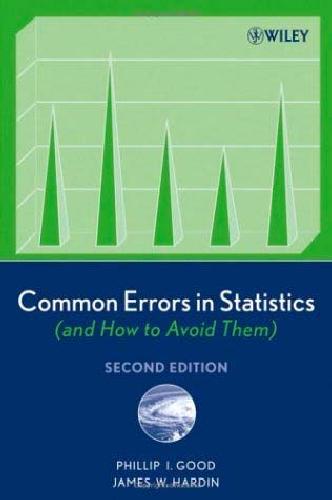

Most ebook files are in PDF format, so you can easily read them using various software such as Foxit Reader or directly on the Google Chrome browser.
Some ebook files are released by publishers in other formats such as .awz, .mobi, .epub, .fb2, etc. You may need to install specific software to read these formats on mobile/PC, such as Calibre.
Please read the tutorial at this link. https://ebooknice.com/page/post?id=faq
We offer FREE conversion to the popular formats you request; however, this may take some time. Therefore, right after payment, please email us, and we will try to provide the service as quickly as possible.
For some exceptional file formats or broken links (if any), please refrain from opening any disputes. Instead, email us first, and we will try to assist within a maximum of 6 hours.
EbookNice Team

Status:
Available0.0
0 reviews
ISBN-10 : 0470388102
ISBN-13 : 9780470388105
Author: Phillip I. Good, James W. Hardin
This set contains: 9780471794318 Common Errors in Statistics (and How to Avoid Them), 2nd Edition and 9780471715757 Introduction to Statistics Through Resampling Methods and R/S Plus?? both by Phillip I. Good and James W. Hardin.
PART I FOUNDATIONS.
1. Sources of Error.
Prescription.
Fundamental Concepts.
Ad Hoc, Post Hoc Hypotheses.
2. Hypotheses: The Why of Your Research.
Prescription.
What Is a Hypothesis?
How precise must a hypothesis be?
Found Data.
Null hypothesis.
Neyman–Pearson Theory.
Deduction and Induction.
Losses.
Decisions.
To Learn More.
3. Collecting Data.
Preparation.
Measuring Devices.
Determining Sample Size.
Fundamental Assumptions.
Experimental Design.
Four Guidelines.
Are Experiments Really Necessary?
To Learn More.
PART II HYPOTHESIS TESTING AND ESTIMATION.
4. Estimation.
Prevention.
Desirable and Not-So-Desirable Estimators.
Interval Estimates.
Improved Results.
Summary.
To Learn More.
5. Testing Hypotheses: Choosing a Test Statistic.
Comparing Means of Two Populations.
Comparing Variances.
Comparing the Means of K Samples.
Higher-Order Experimental Designs.
Contingency Tables.
Inferior Tests.
Multiple Tests.
Before You Draw Conclusions.
Summary.
To Learn More.
6. Strengths and Limitations of Some Miscellaneous Statistical Procedures.
Bootstrap.
Bayesian Methodology.
Meta-Analysis.
Permutation Tests.
To Learn More.
7. Reporting Your Results.
Fundamentals.
Tables.
Standard Error.
p-Values.
Confidence Intervals.
Recognizing and Reporting Biases.
Reporting Power.
Drawing Conclusions.
Summary.
To Learn More.
8. Interpreting Reports.
With A Grain of Salt.
Rates and Percentages.
Interpreting Computer Printouts.
9. Graphics.
The Soccer Data.
Five Rules for Avoiding Bad Graphics.
One Rule for Correct Usage of Three-Dimensional Graphics.
The Misunderstood Pie Chart.
Two Rules for Effective Display of Subgroup Information.
Two Rules for Text Elements in Graphics.
Multidimensional Displays.
Choosing Graphical Displays.
Summary.
To Learn More.
PART III BUILDING A MODEL.
10. Univariate Regression.
Model Selection.
Estimating Coefficients.
Further Considerations.
Summary.
To Learn More.
11. Alternate Methods of Regression.
Linear vs. Nonlinear Regression.
Least Absolute Deviation Regression.
Errors-in-Variables Regression.
Quantile Regression.
The Ecological Fallacy.
Nonsense Regression.
Summary.
To Learn More.
12. Multivariable Regression.
Caveats.
Factor Analysis.
General Linearized Models.
Reporting Your Results.
A Conjecture.
Decision Trees.
Building a Successful Model.
To Learn More.
13. Validation.
Methods of Validation.
Measures of Predictive Success.
Long-Term Stability.
To Learn More.
common errors examples
common rating errors
common mistakes in statistics
common errors in statistical analysis
common errors in data analysis
Tags: Common Errors, Statistics, Phillip Good, James Hardin